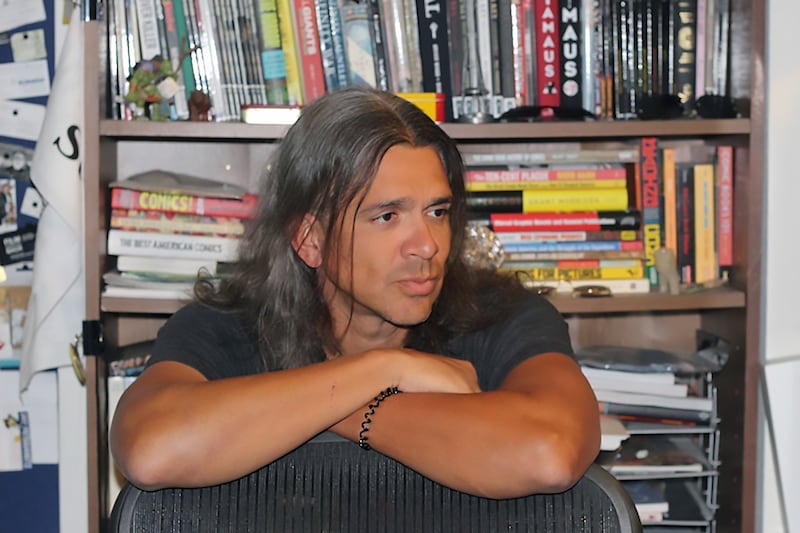Stephen Graham Jones was studying at Texas Tech University in 1991 when the police walked into his class looking for him.
Jones sunk into his seat. At 19, he had been in trouble with the law before, but this time the police weren’t there for something he had done.
A relative of his had suffered burns over most of his body and had been airlifted to the nearby hospital. Jones was the only family member the police could find and they drove him to the Intensive Care Unit.
Jones spent three days at his uncle’s bedside and, watching him fight for his life, began writing his first story. A romance wrought in tragedy, it was unlike the works he has since become known for. Yet, the experience laid the foundation of his career as an experimental horror writer.
“The story was about a girl who wakes up in the ICU," he said during his talk at the Emirates Airline Festival of Literature this weekend. "She’s just barely survived a car wreck and her boyfriend who did not survive is a ghost. He appears at her hospital window and traces a heart in the frost.
“That heart at the centre of all the badness is still what I’m looking for every time I put pen to paper.”
Now 50, Jones has published more than two dozen books, including novels, short story collections, novellas and a comic book.
His latest release, My Heart is a Chainsaw, is rooted in his fascination for slasher films and is just as much a subversion of the genre. The novel follows Jade, a withdrawn part-Indigenous American girl fixated on horror films who begins to suspect her rural lakeside home town has its own slasher.
It is, to quote the book’s online blurb, "Shirley Jackson meets Friday the 13th".
“I think I’ve been trying to get good enough to do My Heart is a Chainsaw for a long time,” Jones said, referencing several characters from his earliest books who have similarities with Jade. “She just kind of stood up on her own and took over, which is what you want when you’re writing. That made it a lot easier.”
Even with his protagonist charging ahead, Jones said it took him three years to come up with a draft he felt confident sending to an editor.
“He said it’s all good until like at this point, at 95 per cent,” Jones said. “He sent me a list of things that wouldn’t work at the end of the novel. He was right. I took those things out that I was doing and it all sang in a different way. It finally came together after eight years, which is amazing.”
“There’s going to be a sequel out before too long, Don’t Fear the Reaper. I really owe that sequel to my editor.”
The second following Jade's story has a release of February 2023, but the character's tale won’t necessarily be ending there. In keeping true to the slasher form, Jones said he intends to extend her story into a third novel, into what will become The Lake Witch Trilogy.
“I think slashers come in trilogies, that’s their natural state,” he said. “Even as we just saw Scream 5, people keep whispering that that’s number one of a new trilogy. So it was like the first trilogy, then the weirdness of four, and then a new trilogy.”
A member of the Blackfeet tribe, Jones said his novels almost always have revolved around Indigenous American characters, and yet, as he was starting out, Jones was careful not to have his readers see his works in light of his cultural background. His character’s ethnicities, he said, were incidental rather than instrumental.
“All my characters are native to me,” he said. “They don’t have to talk about it. I realised that letting the audience know a character is native orients them in a different way towards the story.”
However, as his stories have been garnering interest for film adaptations, Jones said he has been more straightforward with his characters' backgrounds in recent works.
“I talked to people about casting, and I realised the casting director had no cues on how to cast these characters and so my last few books, I’ve been saying it more explicitly in case it ever makes it to some screen, which is weird to me.”
Jones said he often tries to write plots and scenes that scare him, in the hopes that it will frighten and resonate with his readers as well.
“Nearly all my stories come from either terrors I have or nightmares I have that I try to get rid of,” he said. “It doesn’t actually make them go away. When I get them on the page, it gives them 5,000 words of higher resolution, which doesn’t help. I have nightmares where I’m in that world. My novels are not necessarily one of the best places to be.”
Jones said he’s never worried about running out of stories or, as he calls it, “story juice”. To him, fiction is less about ideas than a narrative voice.
“I used to keep all my story ideas in spiral notebooks, and over the last 20 years, I had a bookcase just lined with thick spiral books, but I never went through those things. I don’t need story ideas. I need voices.
"You can’t use muscles to make a voice, you just have to walk around the world with your heart exposed and rub it on the handrails and somehow the voice will sing and the story happens. It’s wonderful when it does, but it’s also painful to walk around the world with your heart on the outside, too.”







